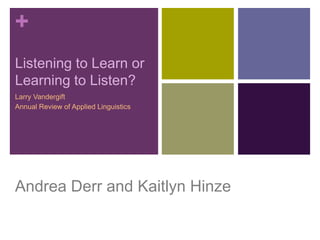
Listening to Learn or Learning to Listen?
- 1. + Listening to Learn or Learning to Listen? Larry Vandergift Annual Review of Applied Linguistics Andrea Derr and Kaitlyn Hinze
- 2. + “Listening is probably the least explicit of the four language skills, making it the most difficult skill to learn” p. 3
- 3. + Cognitive Processes in Listening Comprehension Listening instruction has changed, beginning with the “listening to repeat” approach in the audio-lingual approach, developing into the “question-answer” comprehension approach, and now we use the real-life listening in real time, with communicative tasks and interactions with native speakers. (p. 3) Listeners use top-down processes when they use context and prior knowledge clues. Listeners use bottom-up processes when they develop meaning by using accretion (gradually combining increasingly larger units of meaning). Listeners use different processes determined by the purpose of listening. Research suggests that L2 learners need to learn to use both processes.
- 4. + Cognitive Processes in Listening Comprehension (continued!) Native language listeners carry out processes automatically with little attention to individual words (p. 4). L2 listeners have limited language knowledge as beginning-level learners, so little of what they hear can be automatically processed. They are focused more on the details of what they hear. Research suggests that listening instruction has favored the development of top-down processes, sometimes hindering development of bottom-down processes.
- 5. + Empirical Studies on Listening Instruction Context visuals prepare listeners for text or verbal exchanges. Content visuals support the text. Content visuals do slightly enhance the comprehension of mini- talks, but context visuals decrease comprehension. These visuals require processing, which consumes memory and attention that would be needed to attend to listening comprehension. Beginning level ELLs are limited by working memory constraints. Advance organizers to help listeners focus on desired information are most effective for processing. (p. 6)
- 6. + Empirical Studies on Listening Instruction In regards to DVDs with captions, students acquire more vocabulary and recall passages better with the help of both pictorial and written annotations. Efficient and effective use of bottom-up skills in comprehension appears to be related to the degree to which word recognition skills are automatized. (p. 8) Studies highlight the importance of the effective use of metacognitive strategies for successful listening comprehension. Four strategies have proven most effective: total metacognitive strategy use, comprehension monitoring, questioning elaboration, and online translation.
- 7. + Instructional Observations Limitations of working memory prove that supports provided to the listener should relate directly to the text and the listening task (p. 9). Captions, annotations, and computer programs to slow speech may prove useful for developing word recognition and vocabulary, but their value in teaching students how to listen has been deemed questionable. Visual supports natural to the listening situation can provide important context clues to assist the listener. Context is important to listening, as listeners use any relevant information at their disposal to interpret. A strategies-based approach with beginner-level listeners builds confidence, raises awareness of the listening process, and helps listeners learn to use effective combinations of metacognitive and cognitive strategies to understand texts in real time (p. 10)
- 8. + Teaching Students How to Listen To help listeners develop strategies, teachers need to understand how listeners arrived at answers, especially when incorrect. Recent literature indicates a greater interest in raising student awareness of the process of listening, so a process approach can help listeners learn HOW to listen, guiding them through the stages in real-life listening. Stages of Listening Instruction (and related metacognitive strategies) Planning/ Predicting Stage (planning and directed attention) First Verification Stage (monitoring, planning, and selective attention) Second Verification Stage (monitoring, problem solving, evaluation) Final Verification Stage (selective attention and monitoring) Reflection Stage (evaluation)
- 9. + *Listening comprehension involves two types of processes that interact with each other freely to help listeners construct a meaningful interpretation of what they hear; therefore, teaching listeners how to use the processes will need to balance a top-down, strategies- based approach with remedial, bottom- up training (p. 14)
- 10. + Different Types of Listening Academic Listening (lectures, note taking, etc.) Bidirectional Listening (collaborative listening) Narrow Listening (repeated listening) Listening to train the ear
- 11. + Sociolinguistic Dimensions of Listening Instruction Understanding nonverbal elements and nonverbal paralinguistic elements are important Illustrative gestures corresponding to L2 words can facilitate word recognition and provide important clues for interpreting.
- 12. + Sociolinguistic Dimensions of Listening Instruction (continued!) Research and literature on listening has been minimal, and the authors outline needs for future research: Investigate pedagogic approaches that do not short-circuit the strategic dimension of L2 listening Continue to investigate the relative contribution of top-down and bottom-up processing at different proficiency levels for different tasks Investigate conditions needed for technology-enhanced language learning to exert a beneficial influence on the learners’ listening comprehension strategy development Further research on teaching listeners in classroom settings how to negotiate meaning, clarify misunderstandings, and contribute to the conversation Research into the components of L2 listening to help teachers better understand what needs to be emphasized in listening instruction.
- 13. + Questions! 1.) Read the following quote, then decide whether or not you agree or disagree with it. Explain your answer! “Listening is probably the least explicit of the four language skills (Reading, Writing, Speaking, Listening), making it the most difficult skill to learn” 2.) Take a look back at the four types of listening: Academic, Bidirectional, Narrow, and Listening to Train the Ear. Which of these four types do you think you will incorporate most in your future ESL classroom. Which one do you think creates the best & most successful listeners?
- 14. + Article Vandergift, L. (2004). Listening to learn or learning to listen? Annual Review of Applied Linguistics, 24, 3-25.